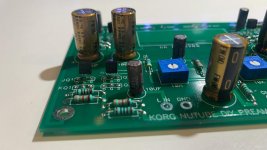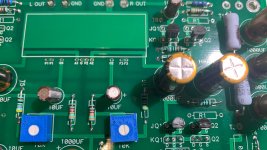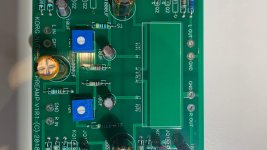Can anyone provide some clarity regarding polarity/phase? I think I need to install a BSC and understanding the situation is vital.
To provide some context, I have built an amplifier with the Korg B1 as the preamp section. I did not reverse any cables internally.
Please correct me if I am mistaken. A bias setting of 10V or above dictates that the positive and negative polarity from amplifier's speaker output reverses. Any value less than 10V results in the amplifier polarity being traditionally matched.
To provide some context, I have built an amplifier with the Korg B1 as the preamp section. I did not reverse any cables internally.
Please correct me if I am mistaken. A bias setting of 10V or above dictates that the positive and negative polarity from amplifier's speaker output reverses. Any value less than 10V results in the amplifier polarity being traditionally matched.
Bias has nothing to do with polarity. Bias determine if 2nd harmonic or 3rd harmonic is dominant.
The Korg B1 is an inverting preamp, it shifts phase by 180degrees.
You should probably read the section in Nelson's build doc for clarification on bias and the effect on sound, it is very enlighting. check here http://www.firstwatt.com/pdf/art_diy_nutube_preamp.pdf
You should probably read the section in Nelson's build doc for clarification on bias and the effect on sound, it is very enlighting. check here http://www.firstwatt.com/pdf/art_diy_nutube_preamp.pdf
Ok. I opted to compensate for phase at the speaker:
A) Does the inverting of speaker cables apply regardless of bias setting?
B) Assuming that A is true, where do I apply the BSC? Does it get put on the positive or negative?
A) Does the inverting of speaker cables apply regardless of bias setting?
B) Assuming that A is true, where do I apply the BSC? Does it get put on the positive or negative?
The circuit itself switches polarity by nature.
You bias the 2nd harmonic with low plate voltage to be positive polarity. When reversing polarity at the speaker, signal, so fundamental becomes positive, but 2nd harmonic reverses as well and becomes negative polarity. That’s what Nelson intended.
You bias the 2nd harmonic with low plate voltage to be positive polarity. When reversing polarity at the speaker, signal, so fundamental becomes positive, but 2nd harmonic reverses as well and becomes negative polarity. That’s what Nelson intended.
Second harmonics reverse polarity. Sorry but I really don't understand this at all. In my opinion distortion and polarity don't affect each other.
NP says the polarity of the harmonics is audible. Read the First Watt paper on the B1K. He discusses the polarity of the second order harmonics and his experience with it.
As I understand this particular project, his findings about negative phase second harmonic is the essence of creating this preamp circuit.
Yikes, 500 pages is a little to much to read. Does this DIY preamp support balanced (XLR) input and output? And is there a good quality complete kit, or shopping list (lets say in the $400 area)?
See here for a BOM with links. It's not quite up to date but will get you started. I'll update soon.
To do it balanced, you'd have to build two of them and use one for each channel.
I have a quick question. I wanna buy Dale resistors for my pre-amp. Can someone tell me how many Watt I should buy? 1/4W or 1/2W. Thanks
My understanding is that the RN55's, which are officially rated at 1/8W, are actually OK to 1/4W. Those are what ship with several of the DIYAudio kits, e.g., the WHAMMY kit, although the spec is 1/4W.
The BOM below uses those, and those devices were specified by 6L6 in an earlier post.
The BOM below uses those, and those devices were specified by 6L6 in an earlier post.
Last edited:
Updated BOM
Resistors
¼W Resistors
(4) 100R 1/4W (71-RN55D-F-100)
Parts Connexion (PRP, Takman)
(4) 1K 1/4W (71-RN55D-F-1.0K)
Parts Connexion (PRP, Takman)
(1) 7.5K 1/4W (71-RN55C7501F/R)
Parts Connexion (Holco, PRP, Takman)
(4) 33.2K 1/4W (71-RN55D-F-33.2K)
Parts Connexion (PRP, Takman, both 33K)
(1) 10K 1/4W for LED (71-RN55D-F-10K)
Parts Connexion (PRP, Takman)
(6) 332K 1/4W (71-RN55D3323F/R)
Parts Connexion (Holco, PRP (330k), Takman (330k))
Other Resistors
(2) 10R 3W (71-CPF310R000FKEE6)
Parts Connexion (Kiwame 5W, Mundorf 5W)
(1) 270R 3W (71-CPF3270R00FKE14)
Parts Connexion (Kiwame 5W)
Note: The Kiwame and Mundorf resistors are longer than the stock parts. There will be
some massaging to get them to fit.
(2) 10K trimmer potentiometers (652-3362P-1-103LF)
Capacitors
(8) 1000uF 25V (647-UPW1E102MHD)
These are filter caps in the power supply
Parts Connexion: Nichicon FG, ES
(6) 10uF 50V (647-USW1V100MDD)
These are coupling caps, etc, and so are critical.
Parts Connexion: Nichicon FG, ES
Diodes
(1) 1N4739 9.1V zener (78-1N4739A)
(1) Green LED (696-SSL-LX40FT3GD)
Chassis mount
(1) 50K Audio stereo volume potentiometer
(688-RK12L1210C0L)
ALPS Blue Velvet (Parts Connexion)
Of course, there are many other options for the pot….
(1) volume knob
Parts Express (many options)
Parts Connexion (many options)
(3) RCA jacks Red
(3) RCA jacks White
Connex Tiffany Style (Parts Connexion)
Connex Rhodium Plated Solderless (Parts Connexion)
Basic Jacks (Parts Express)
(1) DC power barrel jack (Mouser 163-R123B-E)
(2) DPDT on-on toggle switches
Mouser (Many choices)
(1) 24V 500mA DC power supply
Mouser 553-WSU240-0500 or 709-RS25-24
Digikey 364-1274-ND
Rubber screws to help deal with microphonics: AV Mounts Online
Resistors
¼W Resistors
(4) 100R 1/4W (71-RN55D-F-100)
Parts Connexion (PRP, Takman)
(4) 1K 1/4W (71-RN55D-F-1.0K)
Parts Connexion (PRP, Takman)
(1) 7.5K 1/4W (71-RN55C7501F/R)
Parts Connexion (Holco, PRP, Takman)
(4) 33.2K 1/4W (71-RN55D-F-33.2K)
Parts Connexion (PRP, Takman, both 33K)
(1) 10K 1/4W for LED (71-RN55D-F-10K)
Parts Connexion (PRP, Takman)
(6) 332K 1/4W (71-RN55D3323F/R)
Parts Connexion (Holco, PRP (330k), Takman (330k))
Other Resistors
(2) 10R 3W (71-CPF310R000FKEE6)
Parts Connexion (Kiwame 5W, Mundorf 5W)
(1) 270R 3W (71-CPF3270R00FKE14)
Parts Connexion (Kiwame 5W)
Note: The Kiwame and Mundorf resistors are longer than the stock parts. There will be
some massaging to get them to fit.
(2) 10K trimmer potentiometers (652-3362P-1-103LF)
Capacitors
(8) 1000uF 25V (647-UPW1E102MHD)
These are filter caps in the power supply
Parts Connexion: Nichicon FG, ES
(6) 10uF 50V (647-USW1V100MDD)
These are coupling caps, etc, and so are critical.
Parts Connexion: Nichicon FG, ES
Diodes
(1) 1N4739 9.1V zener (78-1N4739A)
(1) Green LED (696-SSL-LX40FT3GD)
Chassis mount
(1) 50K Audio stereo volume potentiometer
(688-RK12L1210C0L)
ALPS Blue Velvet (Parts Connexion)
Of course, there are many other options for the pot….
(1) volume knob
Parts Express (many options)
Parts Connexion (many options)
(3) RCA jacks Red
(3) RCA jacks White
Connex Tiffany Style (Parts Connexion)
Connex Rhodium Plated Solderless (Parts Connexion)
Basic Jacks (Parts Express)
(1) DC power barrel jack (Mouser 163-R123B-E)
(2) DPDT on-on toggle switches
Mouser (Many choices)
(1) 24V 500mA DC power supply
Mouser 553-WSU240-0500 or 709-RS25-24
Digikey 364-1274-ND
Rubber screws to help deal with microphonics: AV Mounts Online
No harm if they are good quality.. I use Belden, mogami canare all the time. Just feel better as they are proper professional audio standard
If you have not tried Gotham Audio Cable, you really should. I've wired my entire system with it, having owned some 'boutique' cable in the past. It's ridiculously good. I won't name names, but I've heard that some very prominent people here have used it in their own systems, as well.
I recently re-wired my system with the new GAC-4/1 Ultra Pro cable, and the difference is utterly obvious. Anyone who would like to hear it for themselves should email me at MY_USERNAME_HERE@gmail.com, and I'll send links to some comparison files.
The Ultra Pro is probably too big to use as hookup wire, but I've used the GAC-4/1, which is 5.4mm and very flexible. (I was very happy with that before the Ultra Pro came out, so it is very good.) It has four internal conductors, so you can get creative with it, if you want. If you don't need that, the GAC-3 or GAC 2-V1 give you much the same shielding but just two conductors.
(FYI, the big difference between the Ultra Pro and the GAC-4/1 is that each of the four conductors in the UP has its own shield, as well as a 'global' shield for the whole thing. This seems to lower the noise and make the high end seem more extended or detailed, but without negative consequences.)
Adding to that, bias will determine the polarity of the 2nd harmonic. For a single-ended
tube like the Nutube, as you lower the Plate voltage below the null point, you begin
generating positive phase 2nd. Raised above, you see negative phase.
After you flip the absolute phase of the output(this being an inverting circuit) this situation
is reversed.
tube like the Nutube, as you lower the Plate voltage below the null point, you begin
generating positive phase 2nd. Raised above, you see negative phase.
After you flip the absolute phase of the output(this being an inverting circuit) this situation
is reversed.
Adding to that, bias will determine the polarity of the 2nd harmonic. For a single-ended tube like the Nutube, as you lower the Plate voltage below the null point, you begin generating positive phase 2nd. Raised above, you see negative phase.
After you flip the absolute phase of the output(this being an inverting circuit) this situation is reversed.
If you could clear up one thing, I would be very grateful. I am compensating for the inverting circuit at the loudspeaker... does that mean I am reversing the speaker wires no matter what the bias is set at? If so, do I put the BSC on the negative then? Thanks.
I am used to BSC standing for baffle step correction. If so, it does not influence
absolute phase, so you would leave it as is.
absolute phase, so you would leave it as is.
If we flip the polarity at the output we’re also flipping the polarity of the fundamental (not only the polarity of the 2nd harmonic). Would that make a difference? I can see that flipping the phase of the 2nd harmonic *relative* to the fundamental (such as changing the plate bias) would make a difference. Am I missing something here? I have yet to receive my pre-ordered kit, so I’ll be excited to try this out.
to soi
Hello soi,
you will be excited to make that listening experience!
I started to play around with the plate voltage of my B1 NUTUBE - pre.
Normal polarity at speaker output of the power amp.
It got really interesting after I changed polarity at speaker output.
You will need a lot of time to listen through your music collection again.
Have fun! The B1 NUTUBE pre is a fantastic preamp!
Greets
Dirk
p.s.: I prefer -more often- 'inverted polarity' at the speakeroutput of the poweramp driven by the B1 NUTUBE. But that is my experience / taste... 😀
Hello soi,
you will be excited to make that listening experience!
I started to play around with the plate voltage of my B1 NUTUBE - pre.
Normal polarity at speaker output of the power amp.
It got really interesting after I changed polarity at speaker output.
You will need a lot of time to listen through your music collection again.

Have fun! The B1 NUTUBE pre is a fantastic preamp!
Greets
Dirk
p.s.: I prefer -more often- 'inverted polarity' at the speakeroutput of the poweramp driven by the B1 NUTUBE. But that is my experience / taste... 😀
Hi everyone,
I'm building 2 pre-amp K1 and I've done a mistake when soldering the JFet... I put them in JQ and ... KQ... Then I realize how stupid it was - I desolder them and in the process one of the JFET leg broke.... Stupid me.
I reliazed I've genuine K170 from a previous project which I matched and solder to the K. So my pre amp(s) are are a mix of J and K as per picture.
Quick question is to check on the bias - any recommendaation for R1 on the K170 ?
I'm building 2 pre-amp K1 and I've done a mistake when soldering the JFet... I put them in JQ and ... KQ... Then I realize how stupid it was - I desolder them and in the process one of the JFET leg broke.... Stupid me.
I reliazed I've genuine K170 from a previous project which I matched and solder to the K. So my pre amp(s) are are a mix of J and K as per picture.
Quick question is to check on the bias - any recommendaation for R1 on the K170 ?
Attachments
I think I read it should be zero for the matched genuines.
“ Q1 and Q2 transistors are selected for specific Idss values, and the R1 values are matched to the Q2 Jfets. For J113 parts, the Idss of Q1 is set to be equal to current through Q2, and with the 2SK parts it is matched and the value of R1 is zero.”
“ Q1 and Q2 transistors are selected for specific Idss values, and the R1 values are matched to the Q2 Jfets. For J113 parts, the Idss of Q1 is set to be equal to current through Q2, and with the 2SK parts it is matched and the value of R1 is zero.”
Last edited:
- Home
- Amplifiers
- Pass Labs
- B1 with Korg Triode


